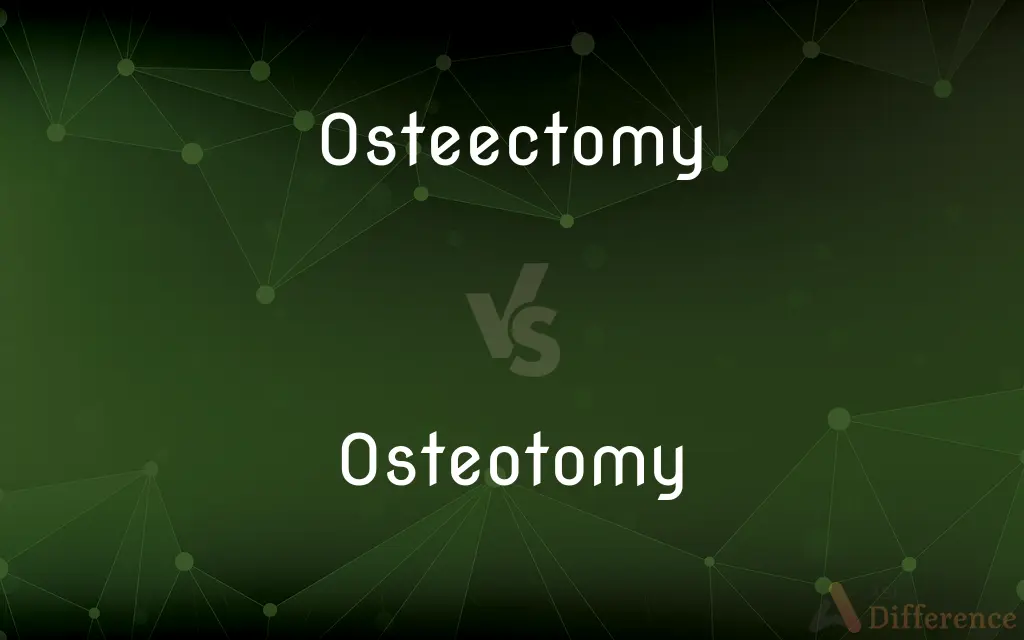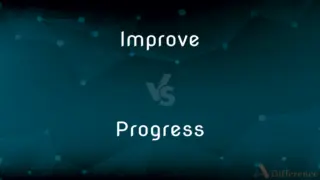Osteectomy vs. Osteotomy — What's the Difference?
By Maham Liaqat & Urooj Arif — Updated on March 29, 2024
Osteectomy involves the surgical removal of bone; osteotomy is the cutting or reshaping of bone, often to correct alignment.

Difference Between Osteectomy and Osteotomy
Table of Contents
ADVERTISEMENT
Key Differences
An osteectomy is a surgical procedure focused on the removal of bone tissue. This could be due to various reasons, including bone tumors, damage, or deformities. The objective is often to excise diseased or unwanted bone to improve patient health or function. On the other hand, an osteotomy involves the cutting or reshaping of the bone. This is typically done to correct misalignments or deformities, improve joint function, or relieve pain, especially in areas like the knee or hip.
Osteectomy procedures are crucial when dealing with bone diseases that could spread or cause significant health issues if not removed. This process can involve taking out small sections or entire areas of bone, depending on the condition's severity. Whereas osteotomies are performed with the intent to preserve as much bone as possible, making precise cuts to realign or reshape the bone for improved function and alignment.
The recovery and rehabilitation process for an osteectomy depends on the extent of bone removal and the specific condition being treated. Patients may require support from prosthetics or undergo further surgeries. In contrast, osteotomy patients typically undergo a planned rehabilitation process to regain strength and mobility in the affected joint, aiming for a return to normal function.
Osteectomies might be recommended for patients where other treatments have failed to alleviate pain or when bone removal is the only option to prevent disease progression. Osteotomies, however, are often considered when there's a need to correct structural abnormalities that cause pain or impaired function, offering an alternative to more invasive procedures like joint replacements.
Both osteectomy and osteotomy are significant surgical procedures that require careful consideration and planning. They are tailored to the individual's specific medical needs, with the goal of improving quality of life through surgical intervention in bone structure and function.
ADVERTISEMENT
Comparison Chart
Definition
Surgical removal of bone.
Surgical cutting or reshaping of bone.
Purpose
Remove diseased or unwanted bone.
Correct misalignments or deformities.
Common Use
Bone tumors, damage, deformities.
Improve joint function, relieve pain.
Outcome
Excision of bone tissue.
Realignment or reshaping for better function.
Rehabilitation
Depends on bone removal extent.
Aimed at regaining strength and mobility.
Alternative To
Often a last resort for relief.
Can be an alternative to joint replacement.
Surgical Focus
Removing problematic bone sections.
Preserving bone while correcting structure.
Compare with Definitions
Osteectomy
Can involve removing small to large sections of bone.
A partial osteectomy was done to remove damaged bone after the fracture.
Osteotomy
Often used to correct deformities.
Hip osteotomy corrected the misalignment causing his discomfort.
Osteectomy
Aims to improve health by removing bone.
The osteectomy helped alleviate the chronic pain from the bone spur.
Osteotomy
Involves precise cuts to preserve bone.
The surgeon made careful cuts during the osteotomy to ensure proper healing.
Osteectomy
Surgical removal of bone due to disease or damage.
The surgeon performed an osteectomy to remove the bone tumor.
Osteotomy
Surgical cutting of bone to correct alignment or function.
Knee osteotomy was performed to realign the leg and relieve arthritis pain.
Osteectomy
May require further treatment or prosthetics.
Post-osteectomy, she received a prosthetic to support the removed bone area.
Osteotomy
Aims for functional improvement without removal.
The osteotomy allowed her to walk more naturally, correcting the previous imbalance.
Osteectomy
Focuses on excising unhealthy bone tissue.
An osteectomy was necessary to prevent the spread of the infection.
Osteotomy
Followed by rehabilitation for strength and mobility.
After the osteotomy, he followed a strict rehab program to regain full knee function.
Osteectomy
(surgery) The surgical removal of a bone.
Osteotomy
An osteotomy is a surgical operation whereby a bone is cut to shorten or lengthen it or to change its alignment. It is sometimes performed to correct a hallux valgus, or to straighten a bone that has healed crookedly following a fracture.
Osteotomy
Surgical division or sectioning of bone.
Osteotomy
(surgery) The surgical procedure of cutting a bone. This is often performed to either lengthen, shorten, or straighten a bone.
Osteotomy
The dissection or anatomy of bones; osteology.
Osteotomy
The operation of dividing a bone or of cutting a piece out of it, - done to remedy deformity, etc.
Osteotomy
Surgical sectioning of bone
Common Curiosities
What conditions can an osteotomy address?
Osteotomies can correct misalignments, deformities, and relieve pain, improving joint function and alignment.
What is the key difference between an osteectomy and an osteotomy?
An osteectomy involves the removal of bone, while an osteotomy entails cutting or reshaping the bone without removal.
Can an osteectomy be performed on any bone?
Technically, it can be performed on any bone, depending on the medical necessity and condition being treated.
How long is the recovery from an osteotomy?
Recovery varies but involves rehabilitation to regain strength and mobility, often spanning several weeks to months.
What are the risks of an osteectomy?
Risks include infection, nerve damage, and the potential need for further surgeries, similar to other surgical procedures.
Can osteotomy delay the need for a joint replacement?
Yes, by correcting alignment and reducing wear, an osteotomy can delay the need for joint replacement surgery.
Are there age restrictions for these surgeries?
While there are no strict age restrictions, the patient's overall health, bone maturity, and specific conditions are considered.
What's the success rate of these surgical procedures?
Success rates vary by condition and procedure but are generally high with proper patient selection and postoperative care.
Can these procedures be reversed?
While osteotomies focus on correction and may be adjusted with further surgery, osteectomies, involving removal of bone, are permanent.
When is an osteectomy recommended?
It's recommended for removing diseased, damaged, or unwanted bone, often when other treatments have failed.
What type of anesthesia is used for these surgeries?
Both procedures typically require general anesthesia, though local anesthesia may be used in certain cases.
How do surgeons decide between an osteectomy and an osteotomy?
The decision is based on the specific medical condition, the goal of surgery (removal vs. correction), and the patient's overall health.
Can lifestyle changes impact the outcome of these surgeries?
Yes, lifestyle changes, including diet, exercise, and avoiding stress on the affected area, can significantly impact recovery and long-term outcomes.
Is osteotomy a common procedure for arthritis?
Yes, osteotomy is commonly used to relieve arthritis symptoms, especially in the knee, by realigning the joint to distribute weight more evenly.
How do patients manage pain after these surgeries?
Pain management typically involves medication, physical therapy, and sometimes additional supportive measures like braces or crutches.
Share Your Discovery

Previous Comparison
Improve vs. Progress
Next Comparison
Invertase vs. SucraseAuthor Spotlight
Written by
Maham LiaqatCo-written by
Urooj ArifUrooj is a skilled content writer at Ask Difference, known for her exceptional ability to simplify complex topics into engaging and informative content. With a passion for research and a flair for clear, concise writing, she consistently delivers articles that resonate with our diverse audience.














































